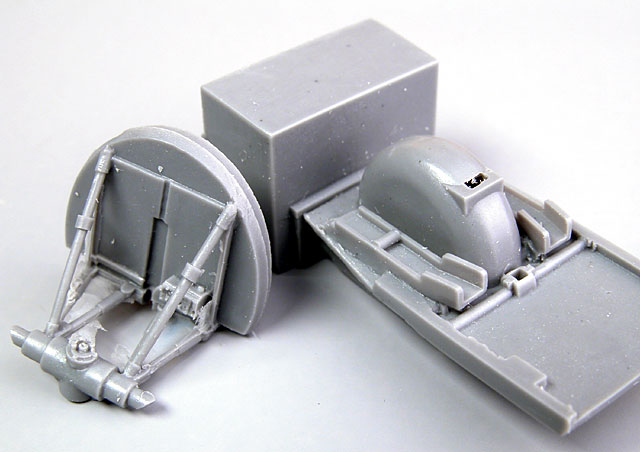|
Gloster Meteor F.4

Classic Airframes
S u m m a r y
|
| Catalogue
Number: |
47XXXX |
| Scale: |
1/48 |
| Contents and Media: |
65 parts in grey styrene; 9 in
clear styrene; 13 parts in dark grey-coloured resin. Decal sheet
with two marking options. 6 pages of instructions and letter-sized
colour marking guide. |
| Price: |
GBP£29.95 (in the European Union)
GBP£25.49 (outside EU) |
| Review Type: |
FirstLook |
| Advantages: |
Important subject with this
variant not previously available as an injection kit in this scale;
beautiful surface detail; accurate outline; thoughtful engineering;
crystal clear transparencies incl. separate sliding section;
excellent resin parts; good quality decals; belly tank and drop
tanks included; clear instructions |
| Disadvantages: |
No gunsight; some chunky sprue
attachment points; engraved detail slightly soft in a small number
of areas. |
| Recommendation: |
Highly Recommended for
experienced modellers. |
Reviewed by Brett Green
Classic Airframes has released the second in their series
of 1/48 scale Gloster Meteors - the Mk.4.
Although the Meteor F.8 and Meteor F.4 bear a strong
family resemblance, there are a surprising number of differences. The most
obvious include the vertical and horizontal tailplanes, engine nacelles
and canopy. This means that the major components of this kit are
substantially different from the plastic in the initial Meteor F.8 release
This latest Meteor
comprises 65 parts in grey injection moulded styrene, 9 parts in
clear injection moulded plastic, and 13 resin parts.
The quality of the plastic parts is very good. The surface
is shiny and smooth (compared to the satin plastic in the initial F.8
release), and panel lines are finely engraved. The recessed detail is very
crisp overall, but a little soft on the belly tank and subtle almost to
the point of invisibility on the elevators. The dive brakes on the
upper and lower surfaces of the wings are well represented by engraved panel
lines. Most of the ejection pin marks on this kit are hidden on the inside surface of
parts except for one big raised pin inside each main wheel well.

Click the thumbnails below to view larger images:
Trailing edges of most flying surfaces are thin,
but the inside surfaces of the rudder halves would benefit from some
sanding. The trailing edge of the wing centre section (inboard of each
nacelle) also seems a trifle thick but a few minutes with a sanding stick
will remedy this area too.
Engineering is thoughtful. The lower centre section of the
wing is moulded as a single part, onto which the inside upper wing parts
(incorporating the nacelles) are joined. The outer wing panels are secured
via a recessed reinforcement strip - much better than the butt-join we
might have otherwise expected.

We do get a butt join for the horizontal tailplanes
though, so some reinforcement with wire or fine brass rod would be a good
measure to prevent later damage.
There are no locating pins, so extra time should be
allocated for test-fitting and aligning parts. Also, sprue attachment
points are a little thick and located in some prominent areas, so take
care when removing and cleaning up parts.
The canopy is clear and thin. Three parts are supplied -
the windscreen, sliding section and the rear - so posing the canopy open
to see all that lovely interior detail will not be a problem. Sprue
attachments are located on the bottom side of clear parts, so care will be
required not to damage the canopy parts when removing them from the sprue.

Resin parts are as impressive as we have
come to expect from Classic Airframes in recent years. The cockpit is very
well done, and accurately represents the floor as being the top of the
nose wheel well. These early Meteors were not fitted with ejection seats,
so we are presented with a WWII style bucket seat with a cushion and
harness cast in place. The instrument panel is a plastic part, and is also
well detailed on the front. The rear of the panel is exposed under the
windscreen, so some extra detailing with plastic rod and fine wire will be
worthwhile. The body of the gunsight is not supplied although the
reflector glass is included as a clear part, with instructions to
glue it to the top of the instrument panel.
The complex mount for the nose wheel is pre-fabricated,
saving the modeller some potentially delicate assembly.

Instructions are logically laid out over 14 steps. Brief notes supplement the exploded view diagrams.
Decals are provided for two aircraft - one camouflaged
Danish aircraft, and an Aluminium painted RAF Meteor.

Options include the distinctive belly tank and
wing-mounted drop tanks.
In common with earlier Classic Airframes releases, the lack of locating
pins will call for extra care and dry-fitting; and a little more cleanup
than average will be required; but there should not be too many traps when
building the kit.
Some modellers who have already built the Meteor F.8 kit have commented
that the installation and alignment of the cockpit and forward wheel well
is a little tricky but, once again, test fitting should address this
issue.
Classic Airframes' 1/48 scale Meteor F. Mk.4 looks like a good prospect
for a modeller who feels ready to tackle something slightly more
challenging than a standard Tamiya or Hasegawa offering.
Highly Recommended to experienced modellers.
Thanks to David at
Hannants for the review sample.
Review and Images Copyright © 2003 by
Brett Green
Page Created 21 November, 2003
Last updated 21 November, 2003
Back to HyperScale Main Page
|
Home | What's
New | Features
| Gallery |
Reviews | Reference
| Forum
| Search